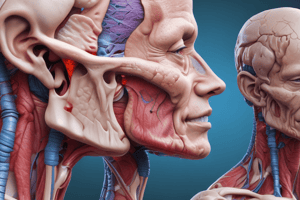Podcast
Questions and Answers
What is the primary focus of anatomical pathology?
What is the primary focus of anatomical pathology?
- Diagnosis of disease through structural changes in tissues and organs (correct)
- Diagnosis of disease through imaging techniques
- Treatment of diseases based on patient history
- Management of clinical trials for drug efficacy
Which technique is NOT typically used in anatomical pathology?
Which technique is NOT typically used in anatomical pathology?
- Immunohistochemistry
- Radiological imaging (correct)
- Hematoxylin and Eosin (H&E) staining
- Fine-needle aspiration
Which aspect of anatomical pathology involves the examination of deceased individuals?
Which aspect of anatomical pathology involves the examination of deceased individuals?
- Surgical pathology
- Cytopathology
- Histopathology
- Forensic pathology (correct)
What does differential diagnosis in anatomical pathology involve?
What does differential diagnosis in anatomical pathology involve?
What is the difference between grading and staging in anatomical pathology?
What is the difference between grading and staging in anatomical pathology?
Which type of pathology examines individual cells typically from fluid samples?
Which type of pathology examines individual cells typically from fluid samples?
Which of the following diseases is NOT typically identified through anatomical pathology?
Which of the following diseases is NOT typically identified through anatomical pathology?
What is the significance of morphological changes as studied in anatomical pathology?
What is the significance of morphological changes as studied in anatomical pathology?
Flashcards are hidden until you start studying
Study Notes
Anatomical Pathology
-
Definition: Branch of pathology that focuses on the diagnosis of disease through the examination of structural changes in tissues and organs, primarily through microscopic evaluation.
-
Core Functions:
- Tissue Examination: Involves processing and analyzing tissue samples (biopsies).
- Autopsy: Comprehensive examination of deceased individuals to determine cause of death.
- Cytopathology: Study of individual cells to diagnose diseases, often from fluid samples.
-
Types:
- Histopathology: Study of tissue architecture and cellular compositions using stained tissue sections.
- Surgical Pathology: Evaluation of tissue samples surgically removed from patients.
- Forensic Pathology: Investigation of cause of death in a legal context.
-
Techniques:
- Tissue Sampling: Biopsy, excision, fine-needle aspiration.
- Histological Staining: Techniques like Hematoxylin and Eosin (H&E) staining to visualize cellular details.
- Immunohistochemistry: Use of antibodies to detect specific antigens in tissue sections.
-
Key Concepts:
- Morphological Changes: Characteristic alterations in cells/tissues that indicate disease.
- Differential Diagnosis: Identifying a disease based on tissue characteristics and ruling out other conditions.
- Grading and Staging: Assessing the aggressiveness of tumors (grading) and spread of disease (staging).
-
Applications:
- Cancer Diagnosis: Critical in identifying and classifying various types of cancers.
- Inflammation and Infection: Identification of inflammatory processes and infectious agents.
- Genetic Disorders: Detection of congenital abnormalities through tissue examination.
-
Importance:
- Provides critical information for treatment decisions.
- Enhances understanding of disease processes.
- Aids in development of new therapeutic approaches.
Conclusion
Anatomical pathology plays a vital role in modern medicine by bridging clinical diagnosis with histological insights, enabling effective patient management and contributing to medical knowledge.
Anatomical Pathology
- Branch of pathology focusing on diagnosing disease through microscopic evaluation of tissues and organs.
- Uses tissue examination, autopsy, and cytopathology as core functions.
- Tissue Examination: analyzing tissue samples (biopsies) to uncover abnormalities.
- Autopsy: Complete examination of deceased individuals to determine the cause of death.
- Cytopathology: Studying individual cells from fluid samples for diagnostic purposes.
- Histopathology: Examining tissue architecture and cellular compositions using stained tissue sections.
- Surgical Pathology: Evaluating tissue samples surgically removed from patients for diagnosis.
- Forensic Pathology: Investigating the cause of death in a legal context.
- Tissue Sampling: Includes biopsy, excision, and fine-needle aspiration.
- Histological Staining: Techniques like Hematoxylin and Eosin (H&E) staining to visualize cellular details.
- Immunohistochemistry: Utilizing antibodies to detect specific antigens in tissue sections, revealing specific cell types or markers.
- Morphological Changes: Characteristic alterations in cells/tissues indicate disease and are crucial for diagnosis.
- Differential Diagnosis: Identifying a disease based on tissue characteristics and ruling out other possibilities.
- Grading and Staging: Assessing the aggressiveness of tumors (grading) and spread of disease (staging) for effective treatment planning.
- Cancer Diagnosis: Critical in identifying and classifying various types of cancers.
- Inflammation and Infection: Identifying inflammatory processes and infectious agents, aiding in appropriate treatment choices.
- Genetic Disorders: Detecting congenital abnormalities through tissue examination.
- Anatomical pathology provides crucial information for treatment decisions, enhances understanding of disease processes, and aids in the development of new therapeutic approaches.
Studying That Suits You
Use AI to generate personalized quizzes and flashcards to suit your learning preferences.




